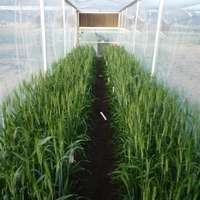How does wheat respond to climate change?

Researchers from The University of Western Australia and CSIRO have made a breakthrough in understanding how wheat crops are likely to respond to potential future climate scenarios.
With climatic conditions across Australia's grain belt changing, the challenge for wheat breeders is to develop new cultivars adapted to rising carbon dioxide levels, higher temperatures and varying rainfall.
In ground-breaking research which takes breeders a step closer to that goal, PhD candidate Eduardo Dias de Oliveira compared how wheat crops responded to various combinations of elevated carbon dioxide levels, high temperatures and drought.
In the first study to compare the interactive effects of the three variables on the growth and yield of wheat, he used four different lines of wheat to test a variety of scenarios. The lines were grown in all combinations of elevated carbon dioxide (700 µL per L), high day-time temperature (3°C above the ambient), and drought (induced at flowering).
The aim was to test how elevated carbon dioxide - known for its ability to enhance crop growth - could soften the effects of high temperature and terminal drought on biomass accumulation and grain yield in wheat.
The results, published in Global Change Biology, shed light on the physiological differences among wheat genotypes in response to environmental stresses, and identified which adaptive traits are best suited to future conditions.
Co-author and co-ordinating supervisor Hackett Professor Kadambot Siddique - who recently returned from the Agriculture and Climate Change conference in Amsterdam - said Dr Dias de Oliviera's study provided significant new knowledge around the causes of yield changes.
"There is no doubt the next generation of productive wheat cultivars will rely on better understanding of physiological processes, and targeting adaptive traits suited to these climate conditions," Professor Siddique said.
The paper, Response of wheat restricted-tillering and vigorous growth traits to variables of climate change was conducted as part of Dr Eduardo Dias de Oliveira's PhD candidature at UWA. Dr Dias de Oliveira has returned to his home country, Brazil, where he is continuing his climate change research in crops and pastures at the University of São Paulo.
More information: "Response of wheat restricted-tillering and vigorous growth traits to variables of climate change." Glob Chang Biol. 2015 Feb;21(2):857-73. DOI: 10.1111/gcb.12769. Epub 2014 Dec 12.
Journal information: Global Change Biology
Provided by University of Western Australia


















